Processing Chickens Off-Grid (and raising meat birds for $4/each)
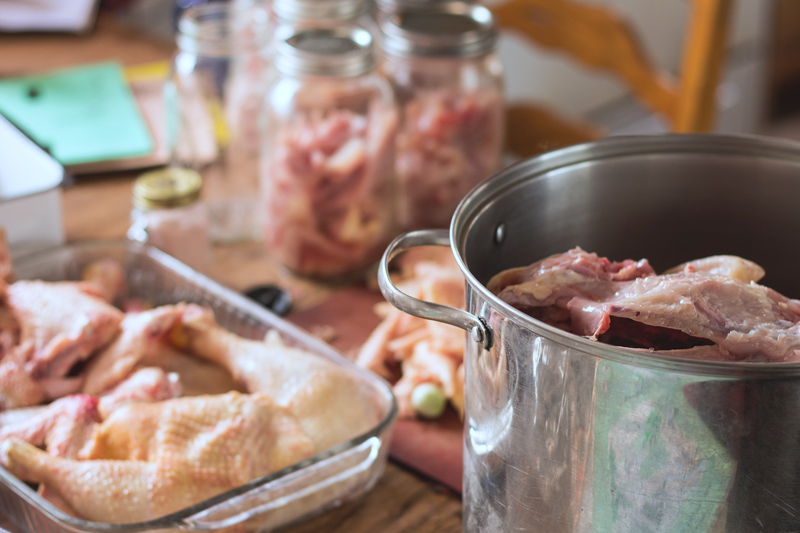
One of our very favorite meals has always been a simple roast chicken. When we lived up north, we used to purchase a fresh pastured chicken weekly for our little family of four. That chicken stretched for several meals and made one of my very favorite foods: chicken broth.
Times have changed quite a bit since then. We’re now a family of seven (almost eight, Lord willing). Those little boys now eat like grown men and a single chicken is just enough for a meal now. And while it has taken us some years to finally get to it, the Lord graciously allowed us to grow our own pastured poultry this year. And, instead of freezing birds, we ate or canned them all.
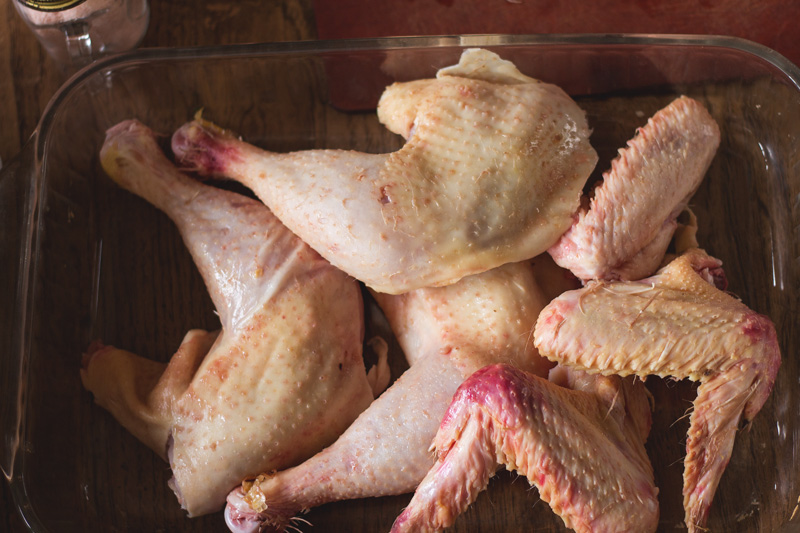
We were swimming in fresh garden potatoes at the time so many meals of homegrown chicken and taters was on the menu. I canned boneless, skinless meat as well as some bone-in meat from legs and thighs. (You can find the process for Canning Whole Chickens in The Doable Off-Grid Homestead.)
On the days I canned I would start the process first thing in the morning.
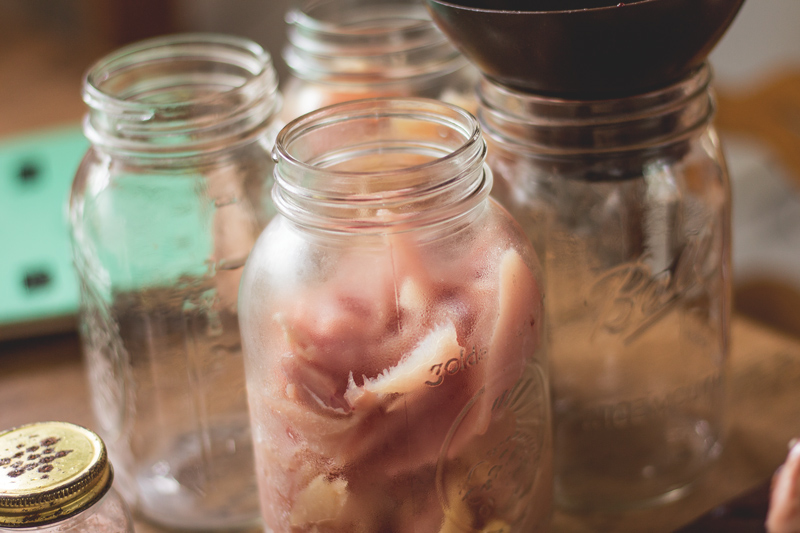
Jars were filled and the lunch pan was filled with wings and leg quarters and thrown in the oven. By late morning the canner began heating and lunch was in the oven. As soon as the jars were filled, the stock pot was started on the stove.
After lunch the canner would finish running and that would give it plenty of time to cool down before the next round. Then right around supper I would strain the broth into jars and get them running through the canner.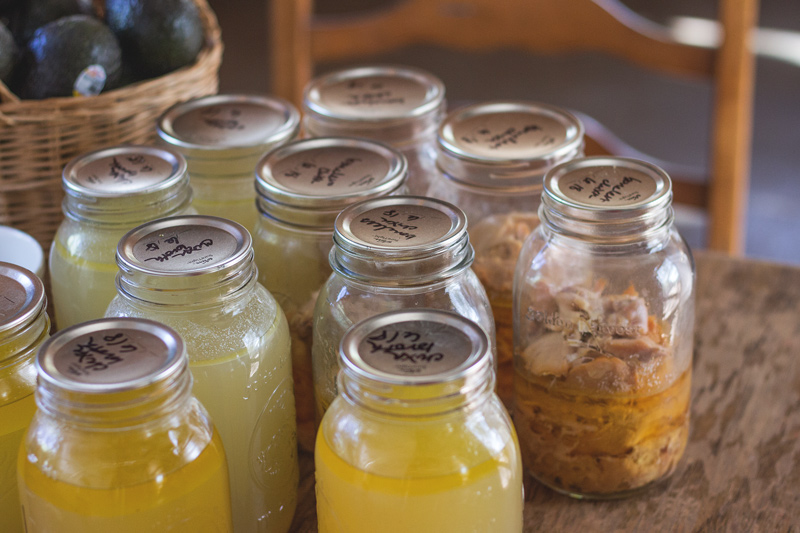
By the end of the day we had meat and broth jars ready for storage. I did this about two to three days per week for three weeks and it was fairly easy going, especially since we didn’t have anything else but potatoes needing to be put up from the garden during this time.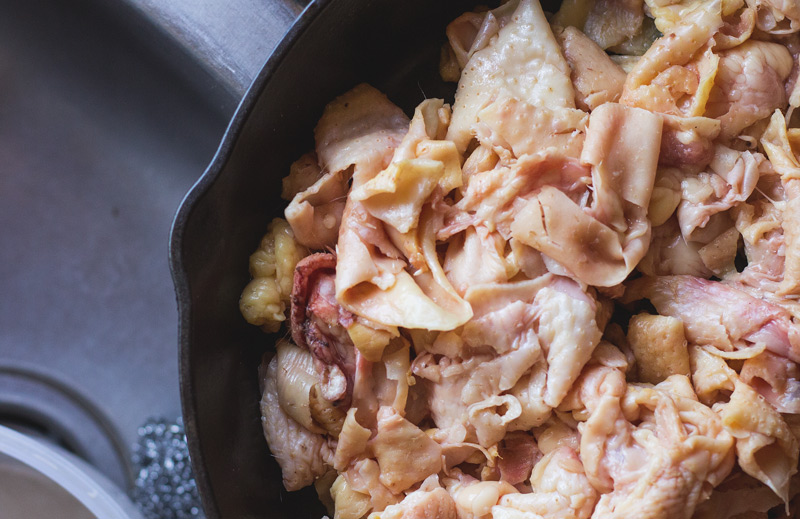
The other product we ended up with was chicken skin and fat. Rendering that down, much like lard, makes for a delicious golden cooking fat perfect for those morning eggs and potatoes.
In the end we got three weeks worth of roasted chicken meals plus many meal-sized quarts of meat and even more of those golden quarts of broth I so appreciate having on hand. The big question, though, is does it make sense to raise meat birds on the type of regimen we had them on?
Cost Analysis
We did some rough math based on what we paid for the chicks plus the local grain we soaked as their ration throughout their lives. The other inputs were skimmed and soured milk from Mabel and kitchen scraps. The former would have gone to pigs or been made into cheese so we don’t really count that, even though with Mabel’s feed there is a small amount of input.
So if you simply count the cost of the chicks plus the cost of the feed and figure we only had 28 chickens out of the original forty, you get a final cost of $4.80/3-4.5 lb bird. Obviously if we hadn’t lost so many chickens to predators and the heat, the price would have been more like $3.80/bird for 35 birds.
And then there is the infrastructure. Their coop was made of reclaimed materials we had lying around so besides screws, that was practically free. The fencing was minimal since we utilized fencing on two sides that we already had up for gardens and laying hens. Another infrastructure input was the bird netting we put over their run to protect them from hawks.
For the sake of this calculation and because we are hoping, Lord willing, to use this infrastructure again and again, we did not count those items into the cost of the birds. But if we absorbed infrastructure costs into this initial batch of meat birds, I roughly calculate that it would have been close to $7.25/bird. Of course that means that future batches of meat birds would have a lower per bird cost.
So would we do it again? Yes, it seems like we might but with a few tweaks to our system and possibly a more hardy chicken breed that can withstand the extremes of our climate.
You never really know how these things are going to go but we are very thankful for how this whole experiment turned out and for the provision of healthy meat (and broth!) for our family.

Baby #6? Yay! May God bless you in this pregnancy, assuming that was a reveal and not a hope. ?
Amy S – Thank you so much! Yes, we are hoping to meet this baby, Lord willing, before summer is out. 🙂
Wonderful, Shannon. Joyous news! God is good.
Hello! We did meat birds this year as well. We started with 55, and by 7.5 weeks, there were 52 of them, and they all ranged in final weights (post-evisceration, with also no feet, heads, necks) between 4 and 7lbs. We did Cornish Cross. I’m not saying it was done perfectly, but I was pretty happy with the process and especially the loss rate. We were very careful about heat for the first 3 weeks. At day 2, 3 and 4, we gave them good yogurt mixed with some feed and grit. We put electrolytes in their water for the first two days. We started removing their food for 12 hours a day starting at 5 days old. For the first five weeks we fed them a feed that was roughly 20-22% protein, and then switched at week five to 18%. On processing day, we removed feed 12 hours before so crops were empty at processing. We had them in a mobile pen, and luckily the heat wasn’t too much for us. But we did equip it with a tarp and had two watering stations. We’ve read that high heat can increase mortality because of them fighting. We had misters ready in case we had a bad heat wave.
But that’s just us! I’m curious how your process was different. 🙂
Hi Jessika – Wow, yours definitely grew much faster than ours. So did you purchase pre-mixed feeds for your birds from a feed store? I think that is our main difference. I wonder if we shouldn’t push up their protein in order to grow them faster in order to avoid raising them into the heat. Do you have any idea what your cost/bird was in the end?
Thanks so much for sharing your experience!
The original cost of the birds was $87. We purchased roughly 8 bags of food for $120. We tried to go as non-commercial as possible, but the local grain suppliers couldn’t guarantee the percentage of protein, and we knew that was important. We’re keeping an eye out for a better wholesaler next time.
52 of the 55 birds made it. Two died as chicks (one from likely genetic health issues, one from accidental smothering from other chicks), one died in on pasture (again from likely nighttime smothering from other chicks; it happens). The end cost is roughly $3.88 per bird. A little more when you add in that we gave them some yogurt at day three, we bought clean bedding ($10), and we added electrolytes to their water for the first week to hopefully help stave off chick death (which may have worked??). We did buy the movable tractor pasture supplies to build a pen, but since we’ll be able to reuse that next year, I’m not including it in the overall costs this year.
I miss having my backyard chickens. So tempted to try some here in the city. Not sure we could handle enough to feed us one bird a week plus eggs, but it would be nice.
Robynd – Ya know, I never thought we’d get to meat birds. Just a few years ago we weren’t even raising enough chix for eggs. Ya gotta start somewhere, right, and just keep plugging away!